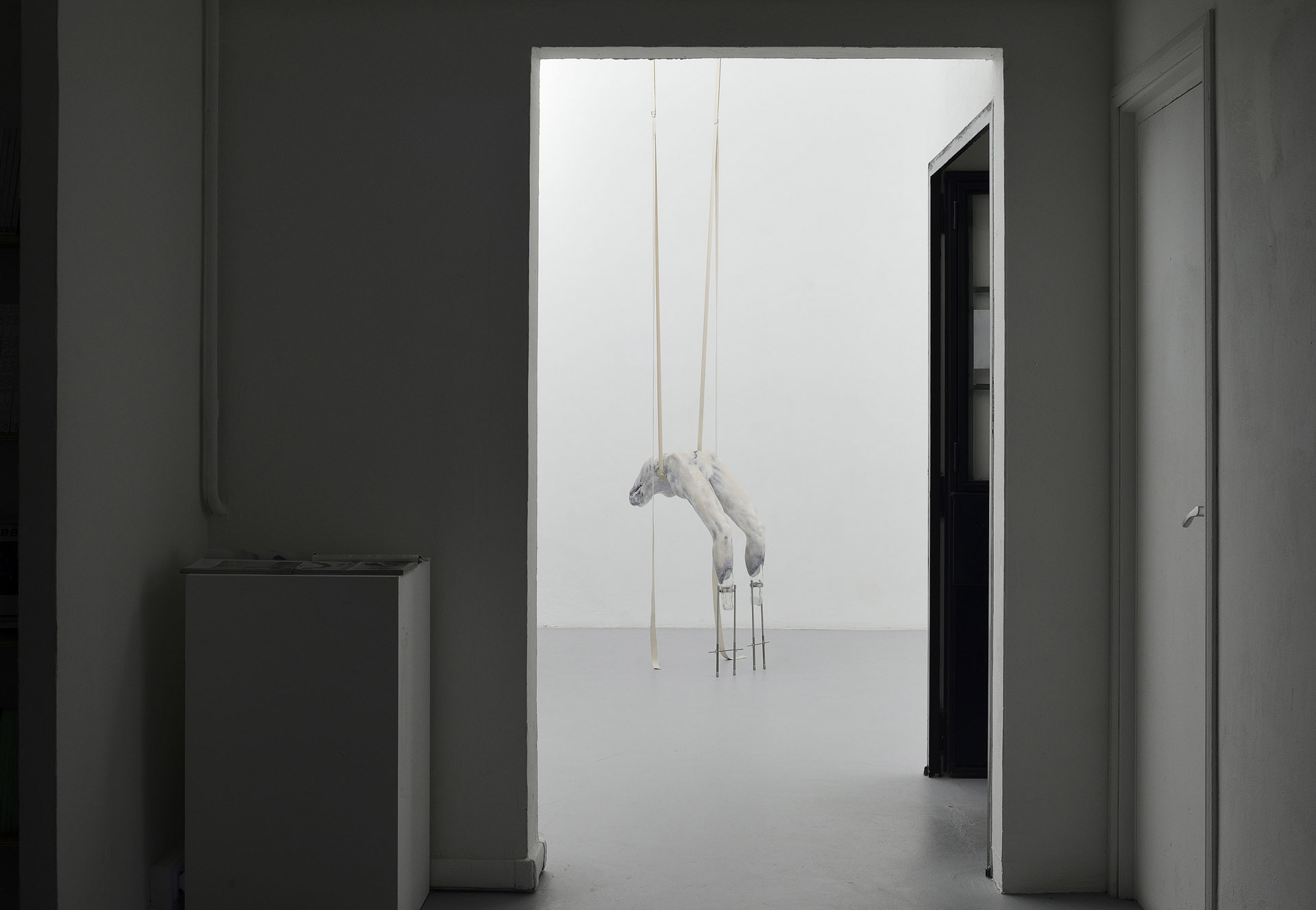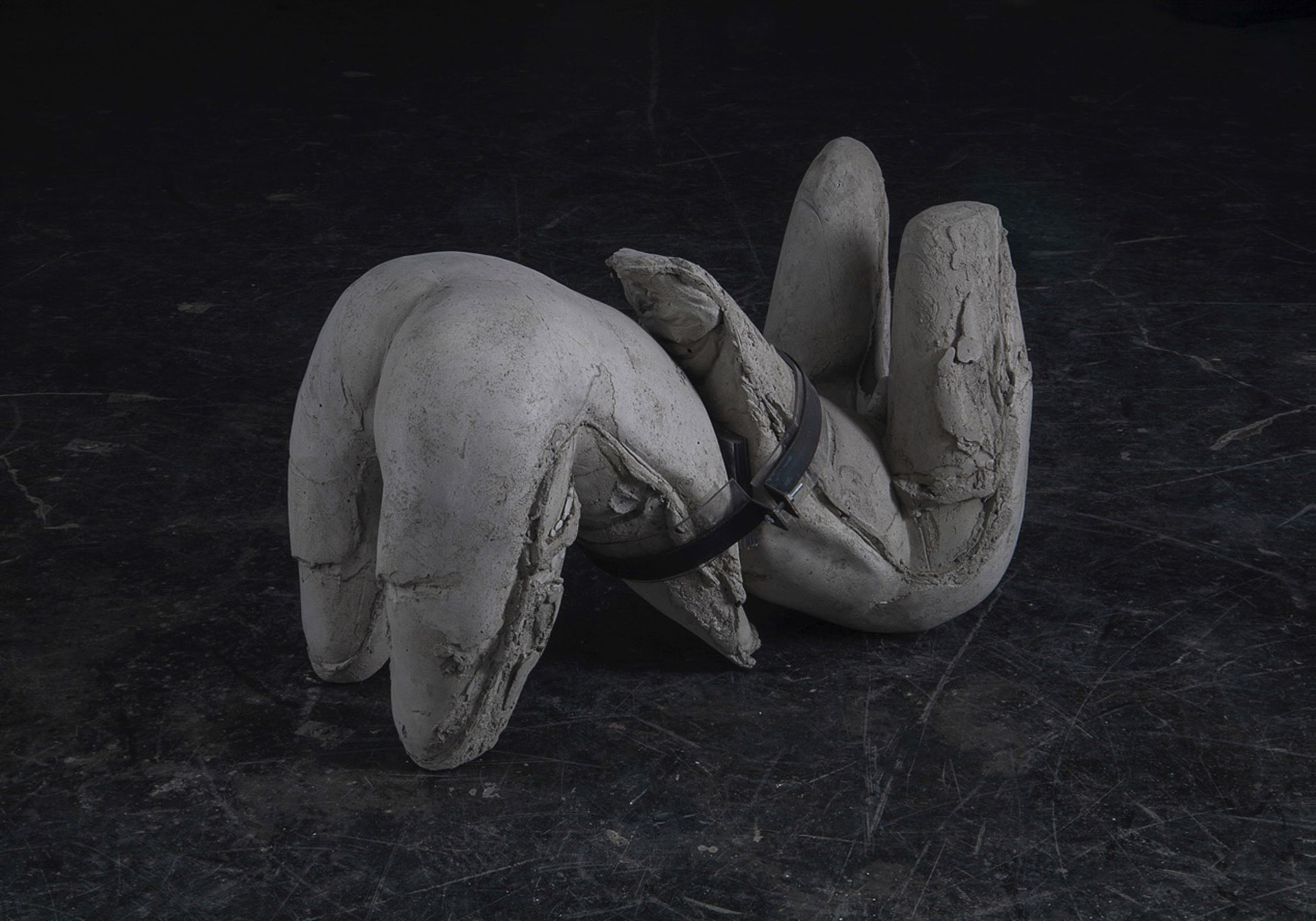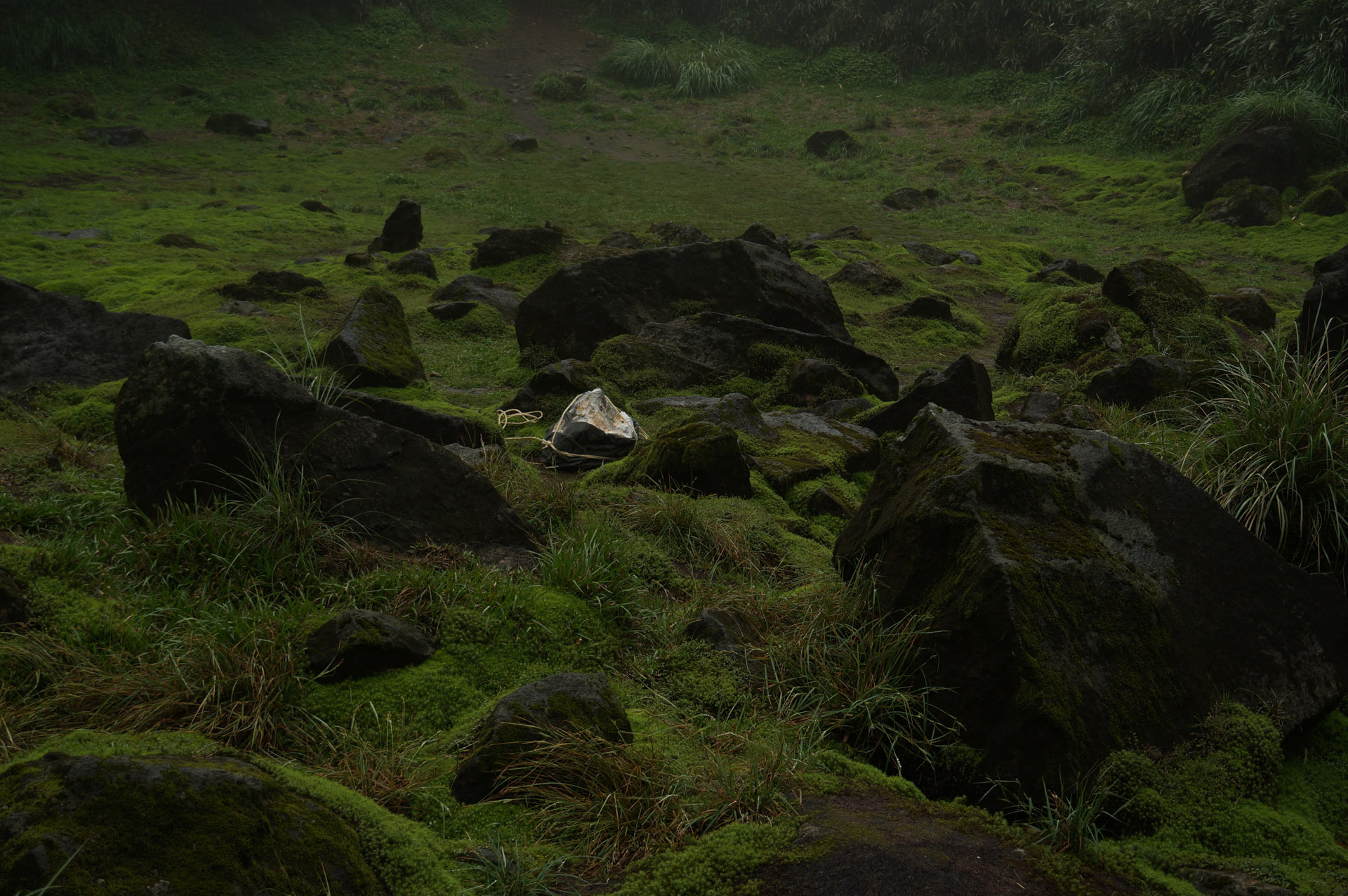Artists: Ivana Bašić, Yu Ji, Hannah Levy
Exhibition title: Incorporea #3
Venue: Basement Roma, Rome, Italy
Date: February 18 – May 14, 2020
Photography: Roberto Apa, all images copyright and courtesy of the artists and Basement Roma
INCORPOREA is a year-long choral exhibition conceived by CURA. for its exhibition space BASEMENT ROMA, set up as to develop and transform itself over time, and aimed at investigating the body in all its folds and meanings: the body in its presence and absence, the social body, the body as a revolutionary space, of antagonism and freedom, expression and research, self-definition and power, identity and gender. Going across different generations and media, starting from new artistic expressions and going back towards the historical avant-gardes, INCORPOREA will investigate the practices that have uncovered, transformed and re -imagined the body and the speculations it has inspired. Moving around the boundaries, meanings and shapes of the body, the exhibition intends to introduce a new corpus of works every month in a sort of endless movement, a constant flow of addition and subtraction, with the aim of exploring an urgent and significant theme, articulating the elements that define it beyond preconceived categories, in today’s ever-shifting scenario.
IVANA BAŠIĆ
(b. 1986, Belgrade, lives and works in NY)
To twist the inside outward, to give contour and inertia to the most far reaching corners of the mind, is not only to make art, but to initiate deep transposition. Through such a holistic approach, New York-based artist Ivana Bašić utilizes her artistic materials as substances that synchronize their elemental properties to the sculptural forms that they take. Such works are often premised on an abstracted sense of primordial matter succumbing to various conditions that are pressed upon it. Both an anatomical and a meta-physiological focus on the corporeal runs through much of Bašić’s work, which spans a multitude of media, including video, and sculptures in stone, stainless steel, silicone, blown glass, and, predominantly, wax. Sculptures made up of these materials are also at times interjected with machinist elements, offering a palpable connection between any given entity and the broader systems within which it must operate.
The cycle Bašić puts into motion with the relationships that she forms between these works elucidates the most primal stages of becoming, being and ceasing to be; from malleable wax bodies, to gasps caught in glass, and stone that turns to dust, only to be compounded upon itself and turned back into solid matter.
Bašić explores the process of metamorphosis, wherein her sculptures undergo a series of transformations: form material to immaterial; from organic to inorganic; from human to insectile and from ground-bound matter into pure idealism. In their dissipation, Bašić’s sculptures evoke the idea of self-dissolution as a potential path to immortality. Through this progression, she builds upon this dynamic by using the universally traumatic awareness of one’s own finite mortality to ignite a transformational and protective process of mental flight or escapism.
To see that Bašić turns the inside out is to recognize the kind of inner turbulence, limitations and expansiveness that fuels one’s own cognizance. The self, itself, is thus central to any examination of her work, yet here ‘the self’ is not individualized or determinately human, but is instead an abstracted, axiomatic sense of ‘the knowable.’ We know what we are based on our limits, both physical and mental. It is within the porousness of that unspoken agreement—which delineates the border between us and them, us and another, us and the other—that Bašić’s work seeks to traverse. With every body of work that she completes, she ties each piece more lucidly to another, some connoting the oscillation that might signify a non-cognitive shift, others personifying such an exertion into somatic configurations. In this way, Bašić susses out those underlying feelings and tendencies that we barely realize we are experiencing, as well as the looming inevitabilities inherent to life itself.
(excerpt from Passing Through the Intangible. Ivana Bašić, by Courtney Malick, CURA. 30)
Recent Solo and Two Person exhibitions: Marlborough Gallery, New York (2021, forthcoming); Chapter 3HREE, Het HEM, The Netherlands (2020); When the whites of the eyes are red, curated by Shehab Awad, Hessel Museum, NY (2017). Selected Group exhibitions: The Body Electric, curated by Pavel Pys, Museum of Art and Design, Miami (2020); I WANT TO FEEL ALIVE AGAIN, Lyles & King, NY (2020); Open Collections: The Artist Takes The Floor at KUMU, Eesti Kuntstimuuseum, Talliin, Estonia (2019); October Athens Biennale 2018, Athens, Greece (2018); and Belgrade Biennale 2018, curated by Gunnar B. Kvaran and Danielle Kvaran, Belgrade, Serbia (2018).
YU JI
(b. 1985, Shanghai, lives and works in Shanghai and Vienna)
The studio resembles something between an archaeological site and a triage unit. On the floor rest several dozen human body segments in casted concrete: a torso with no limbs (leg and arm stumps akimbo); two more slouched torsos bound together, back to back and at the waist, with a steel strap; a headless bust with one arm projecting outward. A layer of detail seems to have sloughed off these human forms, having been sculpted from memory. Yu Ji’s bodies visit the smooth space of the psyche before returning to the physical world.
The fleshy body is an organism: it consumes, defecates, procreates, and pursues myriad forms of desire. From the outside, the human body is a complicated, inefficient, and incorrigible desiring-machine. Though the Flesh in Stone bodies are made of casted concrete, they engage the viewer’s haptic nervous system and are thus surprisingly sensuous. They are, however, not sensual: the presence of genitalia alludes not to sex but to another point on a neural map. I feel my own nerves projecting themselves onto the smooth concrete skin of these smooth, truncated bodies.
The majority of Yu Ji’s Flesh in Stone works adhere to a one-to-one human scale. A leg may swell from its torso and taper away below the knee, or extend past the calf and terminate at the ankle. Another figure’s horizon may be just past the genitals, at which point it terminates. One can complete the figure in his or her mind—difficult to resist forming a ghost-image of the body intact— but only after scanning his or her own body, or activating his or her own cortical homunculus. One can imagine Yu Ji’s figures as orbiting around the plane of immanence but never fully making contact, losing their organs and details as they travel from the three dimensional world into the mental field and back again. Yu Ji’s project is about flows of energy, deterritorialization, and undifferentiated planes. Transcendence, ever-popular, is always an option: Yu Ji’s quiet radicality is in its endorsement of immanence.
(excerpt from BwO: The Art of 吉于. Yu Ji, by Todd von Ammon, CURA. 28)
Recent solo exhibitions include Forager, Edouard Malingue, offsite at Avenue Apartments, Shanghai (2020); Stones in Her Pocket, Project Terrace, Shanghai (2020); Black Mountain, Beijing Commune (2016), Dairy of Sulfur Mining—Pataauw, Mind Set Art Center, Taipei (2016) and Never Left Behind, Beijing C-Space (2014). Recent group exhibitions include Interrupted Meals, HOW Art Museum, Shanghai (2020); And Life Goes On: The special Project for MSAC 10th Anniversary II, Mind Set Art Center, Taipei (2020); May You Live in Interesting Times, 58th International Art Exhibition, Venice Biennale, Venice (2019); SOON ENOUGH: ART IN ACTION, Tensta Konsthall, Stockholm (2018); HUGO BOSS ASIA ART: Award for Emerging Asian Artists,
In Spring 2021, Yu Ji’s first solo exhibition in the UK – Wasted Mud – will be presented by the Chisenhale Gallery, London.
HANNAH LEVY
(b. 1991, NY, lives and works in New York)
Hannah Levy explores the figure and its politics through the objects we surround ourselves with. In her world, the living and the inanimate act as one—all gesturing in their own way towards the same truths. Levy stresses this fluidity by taking conflation to its logical extreme. In her sculptures, the things we consume (baguettes and croissants) are indistinguishable from the surfaces (tables, tiles and chairs) upon which we serve them and the structures (arms and hands) that bring them inside us. Her work disguises itself as mundane to hide its ambition. It is not about creating bodily ambience; it’s about looking at the values these relationships betray.
Tactile seduction is germane to Levy’s installations and sculptures. This physical collapse between intimate and commercial space helps sew together Levy’s thesis. Material attraction becomes more than a punch line or come-on. It is a skin that reminds the viewer of their own touch.
The close-to-home-ness of Levy’s message is the source of its horror and its humor. In placating her viewer with the familiar and its antecedents, she buries them alive. The body is not a safe space but a battleground, and the consequences of that conflict extend into everything that surrounds us. How does one escape these insidious patterns? Levy doesn’t offer us an answer, but she does offer hope. Like her sculptures, these ideas are not impervious but fragile and impermanent like their models. Capable of breaking under the slightest tug or bite, her dysfunctional furniture and food suggest that the values they hold are just as malleable, and that perhaps other values, and another world, may yet be possible.
(excerpt from Design Within Reach. Hannah Levy, by Kat Herriman, CURA. 28)
Among her recent solo shows: Hannah Levy: Pendulous Picnic, Casey Kaplan, New York (2020); Bone-In, Jeffrey Stark, New York (2019); Panic Hardware, Mother’s Tankstation, Dublin (2018); Swamp Salad, C L E A R I N G, Brussels (2018). Selected group exhibitions include: The new frontiers of the contemporary, Fondazione Coppola, Vicenza, Italy (2019); Campi Magnetici (Magnetic Fields), Gio Marconi, Milan (curated by Ceclia Alemani), (2019); Wege zur Welt – Hildebrand Collection, G2 Kunsthalle, Leipzig (2019); Insane in the Membrane, Sammlung Philara, Düsseldorf (2018); The Artist is Present, Yuz Museum, Shanghai, China (curated by Maurizio Cattelan), (2018).
Ivana Bašić, Stay inside or perish, 2016, wax, glass, pressure, oil paint, weight, rigidity, stainless steel, leather, elastic. Installation view, BASEMENT ROMA, 2021. Photo credit: Roberto Apa, courtesy the artist and Marlborough Gallery, New York
Ivana Bašić, Stay inside or perish, 2016, wax, glass, pressure, oil paint, weight, rigidity, stainless steel, leather, elastic. Installation view, BASEMENT ROMA, 2021. Photo credit: Roberto Apa, courtesy the artist and Marlborough Gallery, New York
Ivana Bašić, Stay inside or perish, 2016, wax, glass, pressure, oil paint, weight, rigidity, stainless steel, leather, elastic. Installation view, BASEMENT ROMA, 2021. Photo credit: Roberto Apa, courtesy the artist and Marlborough Gallery, New York
Ivana Bašić, Stay inside or perish, 2016, wax, glass, pressure, oil paint, weight, rigidity, stainless steel, leather, elastic. Installation view, BASEMENT ROMA, 2021. Photo credit: Roberto Apa, courtesy the artist and Marlborough Gallery, New York
Ivana Bašić, Stay inside or perish, 2016, wax, glass, pressure, oil paint, weight, rigidity, stainless steel, leather, elastic. Installation view, BASEMENT ROMA, 2021. Photo credit: Roberto Apa, courtesy the artist and Marlborough Gallery, New York
Ivana Bašić, Stay inside or perish, 2016, wax, glass, pressure, oil paint, weight, rigidity, stainless steel, leather, elastic. Installation view, BASEMENT ROMA, 2021. Photo credit: Roberto Apa, courtesy the artist and Marlborough Gallery, New York
Ivana Bašić, Stay inside or perish, 2016, wax, glass, pressure, oil paint, weight, rigidity, stainless steel, leather, elastic. Installation view, BASEMENT ROMA, 2021. Photo credit: Roberto Apa, courtesy the artist and Marlborough Gallery, New York
INCORPOREA #03, Installation view, BASEMENT ROMA, 2021. Photo credit: Roberto Apa
Hannah Levy, Untitled (2014-15), video. Installation view, BASEMENT ROMA, 2021. Photo credit: Roberto Apa, courtesy the artist and Casey Kaplan, New York
Hannah Levy, Untitled (2014-15), video. Installation view, BASEMENT ROMA, 2021. Photo credit: Roberto Apa, courtesy the artist and Casey Kaplan, New York
INCORPOREA #03, Installation view, BASEMENT ROMA, 2021. Photo credit: Roberto Apa
INCORPOREA #03, Installation view, BASEMENT ROMA, 2021. Photo credit: Roberto Apa
INCORPOREA #03, Installation view, BASEMENT ROMA, 2021. Photo credit: Roberto Apa
INCORPOREA #03, Installation view, BASEMENT ROMA, 2021. Photo credit: Roberto Apa
Ivana Bašić, Stay inside or perish, 2016, wax, glass, pressure, oil paint, weight, rigidity, stainless steel, leather, elastic. Installation view, BASEMENT ROMA, 2021. Photo credit: Roberto Apa, courtesy the artist and Marlborough Gallery, New York
Yu Ji, Flesh in Stone – Rema Rema 1901, 2018, cement, iron. Photo credit: Yu Ji, courtesy of the artist and Sadie Coles HQ, London
Yu Ji, Flesh in Stone – Rema Rema 1710, 2017, concrete, iron. Photo credit: Yu Ji, courtesy of the artist and Sadie Coles HQ, London
Yu Ji, Flesh in Stone – Rema Rema 1710, 2017, concrete, iron. Photo credit: Yu Ji, courtesy of the artist and Sadie Coles HQ, London
Yu Ji, PATAAUW STONE [still], 2015, HD Video, 23’ 45’’. Photo credit: Yu Ji, courtesy of the artist and Sadie Coles HQ, London
Yu Ji, PATAAUW STONE [still], 2015, HD Video, 23’ 45’’. Photo credit: Yu Ji, courtesy of the artist and Sadie Coles HQ, London




















